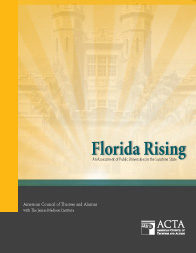The Center for American Progress’ (CAP) recent report “A Great Recession, a Great Retreat” makes a case for increased state funding for higher education. The basis for this recommendation is that state disinvestment has driven up the price of tuition, and this is undoubtedly true. Whether it is the whole truth is a question that deserves some scrutiny (coming soon in another post), and CAP’s proposed solution is similarly a partial solution that cannot be fully effective in isolation.
In short, the report’s central suggestion is that the federal government spend more on higher education and predicate this funding on renewed state investment, in other words, matching funds, under the name “Public College Quality Compact.” If that sounds familiar, it’s because the President’s proposed free community college plan (which we’ve covered in part here) draws on the idea: 75% of the funding for that plan will be provided by the federal government, but it won’t be disbursed until states provide the other 25%.
The hope for increased state support is unlikely to pan out. States are still struggling to make ends meet after the recession and increased spending on education will either require new taxes (at the state level, in addition to the national tax increases already proposed) or that funding be pulled from other, already established programs. Both options are politically difficult.
Even if such funding increases could be achieved, this is an incredibly shaky base on which to build—as soon as the next recession strikes, that money will disappear, and universities will have done nothing to address out-of-control spending. It’s important to realize as well that rather than going to increased instruction hours or better support systems for struggling students, funding increases are just as likely to end up buying yet another under-used building or paying for the salaries of another layer of campus bureaucrats.
Thankfully, we’ve got more options than accepting the status quo or hoping for funding increases. One way for colleges and universities to reduce the price of tuition, without depending on the ups and downs of state revenue collection, is to take cost-cutting seriously, starting with increased transparency and accountability measures. Some schools have already begun.
The University of North Carolina system, for instance, maintained affordable tuition prices as well as a 6-year graduation rate well above the U.S. average, despite decreases in state funding in the wake of the recession. How has the system achieved these results? The John W. Pope Center for Higher Education Policy’s Jenna Ashley Robinson offers this explanation:
Across the system, 535 vacant positions were eliminated in 2012-13, effectively erasing what some view as slush funds (funds that come when campuses keep jobs unfilled but continue receiving appropriations for them). And schools in the UNC system spend a larger percentage of their budgets on instruction (and less on support services) now than they did at the beginning of the recession.
This is consistent with what ACTA recommends in Florida Rising. Florida falls into the funding category that CAP maintains is the most worrying: states that saw higher ed funding reduced by more the 20%. Despite this, in 2013, the University of Florida still had the lowest tuition rate in the American Association of Universities. How?

For one, the Florida State University System began requiring its schools to produce annual Accountability Reports and Work Plans. This has done a great deal to keep administrators and trustees appraised of the financial situation of each school and to highlight opportunities for cost-cutting. Administrative expenditure dropped and online learning increased.
One of the most meaningful reforms that grew out of these reports was the decision to engage in academic prioritization. That is, every program offered was analyzed for cost-effectiveness and fit within institutional mission, and those that didn’t match up were terminated. Between May 2011 and May 2012, 21 programs were cut, six suspended, and three were not approved. This was not an across-the-board slashing of programs—twelve programs were added in the same period—but a thoughtful consideration of the costs and benefits associated with each program.
Central is the recognition that no university can be everything to everyone. A diversity of institutions adds strength to the system and helps avoid “mission creep” or the tendency to add more and more programs without an overarching strategic framework or understanding of how those programs might fit with others in the System. Now, the Systems’ “Board of Governors’ policy requires campus boards of trustees to ensure that new degree programs are consistent with the institution’s role within the System, and not duplicative of programs offered at other state institutions.”
This approach is also championed by Robert Dickeson in Setting Academic Priorities, a booklet published by ACTA. There, he makes the case that such prioritization is of critical importance—the universities that survive the next ten years will be those that successfully carve a niche for themselves. Indeed, there is evidence from recent enrollment data that the “institutions that thrive know whom they serve; offer attractive, relevant niche programs; and market themselves well.” Every university can take steps right now to reduce tuition and improve quality. Waiting for state funding to return before trying to rein in the price of tuition is a disservice to students and a waste of time.
